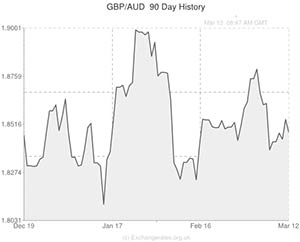
Overnight unexpectedly impressive Australian employment data helped the ‘Aussie’ post widespread advances against the majority of its currency rivals.
Consumer confidence in the South Pacific nation may have slipped in response to job losses in the car manufacturing sector, but employment gains in the services sector have clearly offset these declines.
The Australian Dollar advanced by 0.7 per cent against the US Dollar and recorded significant gains against the Yen and Euro.
Economists had expected the Australian economy to add 15,000 positions in February, but it actually added 47,300 in the nation’s largest monthly jobs gain for over 20 years.
January’s employment data was positively revised to a gain of 18,000 positions.
Full time employment surged by 80,500 last month while part time employment declined by 33,000.
In February the Australian participation rate rose from an upwardly revised 64.6 per cent to 64.8 per cent.
However, while this result is certainly upbeat, industry experts Paul Brennan and Joshua Williams were quoted as observing; ‘The ABS says that in February the incoming rotation group had a higher proportion of employed persons, such that 37 per cent of the increase in total employment in the month was due to this new rotation. If we apply this proportion to the seasonally adjusted employment result, it suggests that almost 17,600 of the 47,300 total gain was from statistical changes.’
The Australian Dollar adopted a bullish relationship with peers like the Pound after the report was released.
However, the ‘Aussie’ did lose some ground following the publication of less-than-impressive Chinese data.
In the latest sign that China’s economy is struggling, the nation’s industrial production and retail sales reports came in below forecast levels.
Industrial production increased by 8.6 per cent in February, year-on-year, verses expectations for an increase of 9.5 per cent.
Retail sales were up 11.8 per cent on the year rather than the 13.5 per cent expected.
The disappointing Chinese figures prompted this response from economist Yao Wei; ‘This is a very fast deceleration. This is really beyond the tolerance of the Chinese government. As a result, I think they will cut the required reserve ratio quite soon or do some easing.’
The Pound was also trading lower against the Australian Dollar as a result of an unforeseen decline in the UK RICS house price balance in February. While economists were expecting a figure of 52 per cent, the report actually came in at 45 per cent in a sign that UK house price growth is easing.
Before the weekend further GBP/AUD movement may be inspired by China’s foreign direct investment report and UK trade balance figures.
Current Australian Dollar Exchange (AUD) Rates
Australian Dollar (AUD) Exchange Rates
[table width=”100%” colwidth=”50|50|50|50|50″ colalign=”left|left|left|left|left”]
Currency, ,Currency,Rate ,
Australian Dollar, ,US Dollar, 0.8962,
,US Dollar, 0.8962,
Australian Dollar, ,Euro, 0.6539,
,Euro, 0.6539,
Australian Dollar, ,Pound, 0.5360,
,Pound, 0.5360,
Australian Dollar, ,New Zealand Dollar, 1.0655,
,New Zealand Dollar, 1.0655,
US Dollar, ,Australian Dollar, 1.1157,
,Australian Dollar, 1.1157,
Euro, ,Australian Dollar, 1.5294,
,Australian Dollar, 1.5294,
Pound Sterling, ,Australian Dollar, 1.8673,
,Australian Dollar, 1.8673,
New Zealand Dollar, ,Australian Dollar, 0.9366,
,Australian Dollar, 0.9366,
[/table]

Comments are closed.